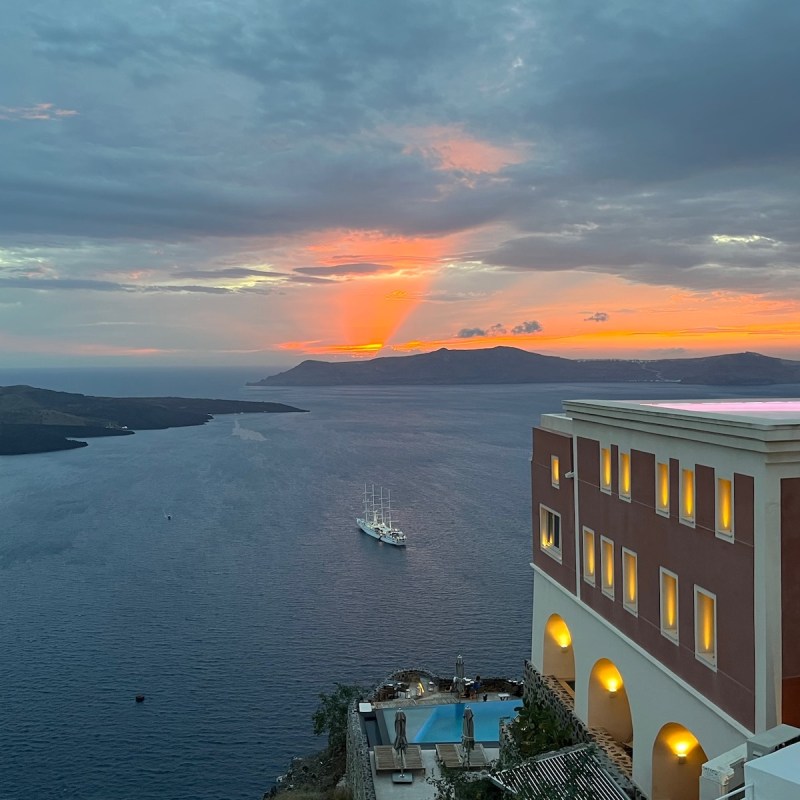
I just returned from my first cruise to the Greek Islands and it won’t be my last. Seven days sounded like plenty of time to experience the islands of the Aegean Sea, but it wasn’t. I already have a list of places to explore more when I return.
Videos by TravelAwaits
It won’t be easy to sum up my favorite experiences in just one article, but I’ll try. I’ve chosen a combination of our favorite sceneries and the most interesting historical sites. Along the way, we met fascinating people, ate delicious food, and came to understand why Greece is on many people’s bucket lists. It was a trip that exceeded all expectations.
My cruise of the Greek Islands was hosted by Celestyal Cruises. All opinions are my own.

1. Thessaloniki Promenade
My husband, Jason, and I boarded our cruise ship, Celestyal Crystal, in Athens on a Saturday afternoon. By Sunday morning, we were in Thessaloniki, the second-largest city in Greece. We opted to join an organized excursion with the cruise ship. Once the ship docked, we disembarked and headed to our assigned tour bus.
Our guide, Panos, has spent much of his adult life living in Thessaloniki, a city he clearly adores. Throughout our 4-hour tour, he shared the history of the city along with a glimpse of local life.
Our first stop was at White Tower, located next to the sea and generally considered the symbol of the city. It was originally part of the fortification walls to protect the city from invaders. And while the tower was interesting, it was the seaside promenade that Jason and I enjoyed the most.
Panos explained how this pathway runs for 2.5 kilometers (1.55 miles) and is a popular spot for locals to walk, run, and bicycle. After our tour ended, Jason and I returned to the promenade for a stroll before returning to the ship. It was a lovely way to watch locals enjoying their Sunday afternoon walking dogs, pushing strollers, and — like us — enjoying the warm and sunny day. It was the perfect introduction to life in Greece.

2. Church Of St. Demetrios
Our final stop on the tour of Thessaloniki was the Church of St. Demetrios, a historic site with a long and complicated history. Long before churches were built on this site, it was a Roman bath. The first of many churches was built here in the 4th century A.D.
Over the next several centuries, there would be many fires and multiple reconstructions. During the Ottoman Empire, it was converted into a mosque. When the Ottomans left, it reverted to a church, but the Great Fire of 1917 brought significant destruction. It was this fire and the subsequent rebuilding that resulted in the discovery of the underground crypt; it had remained hidden for 500 years.
After a tour of the church, our group descended into the dark and cool crypt. Today, visitors can explore the underground rooms and see many of the archeological artifacts discovered.

3. Ancient City Of Ephesus
After departing Thessaloniki in the afternoon, our ship sailed overnight to Kusadasi, Turkey. The day’s excursion was included in our cruise, so we boarded our bus and headed to Ephesus.
Once considered the most important trading center in the Mediterranean, the early history of Ephesus is not fully known, but according to legend, it was founded in the 11th century B.C. by the Ionian Prince Androcles. As we walked through the remains of the city, we were amazed by the layers of history. Myriad kings, emperors, and empires ruled Ephesus over the course of 26 centuries.
Our guide, Can (pronounced John), led us to the best known sights including the Temple of Hadrian, the Odium (theater), and the Celsus Library. In between, we saw public toilets that once had running water, a fountain, a hospital, and a brothel. Since only 10 percent of the city has been excavated, we also watched as a group of archeologists worked on unearthing additional buildings.
Pro Tips: Ephesus has very little shade. When visiting, come prepared with sunscreen, water, and a wide-brimmed hat. Also, many of the pathways are marble and can be slick. Be sure to wear shoes with good tread.

4. Medieval City Of Rhodes
On the 4th day of the cruise, we found ourselves on the island of Rhodes where we joined the included half-day excursion. In the second half of the tour, we would be exploring Greco-Roman ruins — something I expected in Greece. But I was surprised to find our first stop was a medieval city. Looking more like something I’ve seen in England or France, Rhodes Old Town was built by the Knights of St. John in the 14th century.
We arrived early in Rhodes Old Town while it was still relatively quiet and spent 30 minutes walking its cobblestone streets. This beautifully-preserved fortified city is still a vibrant neighborhood filled with homes, shops, restaurants, galleries, and museums. Surrounded by a 4-kilometer (2.49-mile) wall and protected by a triple moat, the Old Town was named a UNESCO World Heritage Site in 1988.
When our tour of the island concluded, Jason and I returned to Old Town for lunch and then explored it further. The main streets are quite busy with tourists during the day, but once we got away from the shops and restaurants, there were few people and we were able to appreciate the medieval architecture and get a sense of local life.

5. Acropolis Of Lindos
When anyone says Acropolis, it’s assumed the location is Athens. But it turns out the word simply refers to “the upper settlement of an ancient Greek city.” At one time, most Greek cities had an acropolis, a place where locals would go to worship or to escape invaders.
The second half of our time on Rhodes Island was in the town and Acropolis of Lindos. We began by walking through the myriad shops and cafes of Lindos, all painted white and beckoning tourists. Then, we began our steep ascent to the top.
The climb to the acropolis is not for the faint of heart. It is a steep, slick, and often crowded pathway. Those with a fear of heights may also find it difficult. But once at the top, we were rewarded with views of 3,000-year-old ruins surrounded by the deep-blue color of the Mediterranean Sea.
Like many similar sights in Greece, the ruins here are from multiple civilizations and empires. They are literally layers of history. We spent half an hour climbing the steps and appreciating the differing views. Then, we returned to the village below, grabbed a drink, and returned to our bus.
Pro Tip: While we followed our guide up the paved path to the acropolis, we opted to walk down the much less-crowded dirt path, thus circumventing hundreds of other people. No matter which path you use, sturdy shoes with good tread are essential.

6. Sunset Dinner In Santorini
Our ship arrived late in the afternoon in Santorini. Instead of an excursion, we decided to enjoy a romantic, sunset dinner in the town of Fira.
The process of getting to dinner wasn’t easy. There is no port in Santorini, so ships must anchor offshore and use tenders (small boats) to transport guests to the island. From there, guests can reach the town of Fira — perched high on the hilltops — by cable cars, donkeys, or on foot. We had hoped to use the cable cars, but the lines were extremely long. Despite having dressed for an upscale dinner, we opted to walk the steep path so we could maximize our time in Fira. It was certainly a good workout.
While the start of our time in Santorini was less than ideal, the dinner was perfect. One of the cruise ship staff had recommended Ohh Boy Restaurant & Bar and it did not disappoint. From our patio table, we could see our ship floating in the Aegean below. Behind it were two smaller islands that appeared uninhabited. Over the course of our meal, we watched the sun sink into the sea lighting up the sky in bright orange. To make things even better, the food was delicious. Accompanied by a glass of local white wine, I told Jason that this was exactly what I imagined Santorini would be like.

7. Mykonos Town
I was excited that our ship was scheduled to spend most of the day in Mykonos so we would have plenty of time to explore it. While there were several interesting excursions offered, we opted to go on our own.
After our ship docked, we were among the first people to disembark, so the streets of Mykonos Town (also known as Chora) were relatively empty. We immediately fell in love with the white buildings, trimmed in blue, yellow, and pink, set against the streets paved with white stones. Frequently, we saw bougainvillea in planters adding even more color to the scene.
Our first stop was the famed windmills, seen in many photos of the island. Built by the Venetians in the 16th century, these were used to mill wheat. As many as 25 windmills once could be found in Mykonos, but just 16 remain today.
Next, we wanted a snack, so we popped into Gioras, the oldest working bakery on the island. The tables and cases were full of delicious-looking pies and pastries. We sampled the cheese, spinach, potato, and chicken pie. All were delicious and I only wish we could have eaten more.
After some shopping and continued sightseeing, we ended our day on Mykonos with an early dinner near the harbor. The food was good, but what was most memorable was the appearance of the island mascot, Petros (or Peter) the Pelican. Legend has it that an injured pelican was nursed back to health by a local fisherman in the 1950s. Since the bird could no longer fly, it made the island its home and was adopted by the residents. The original Petros died in 1986, but a few substitutes have since been recruited. Today, they can be seen frequently by the harbor, but are equally comfortable strolling the town’s scenic lanes.
For all of Greece coverage, check out articles like these:

